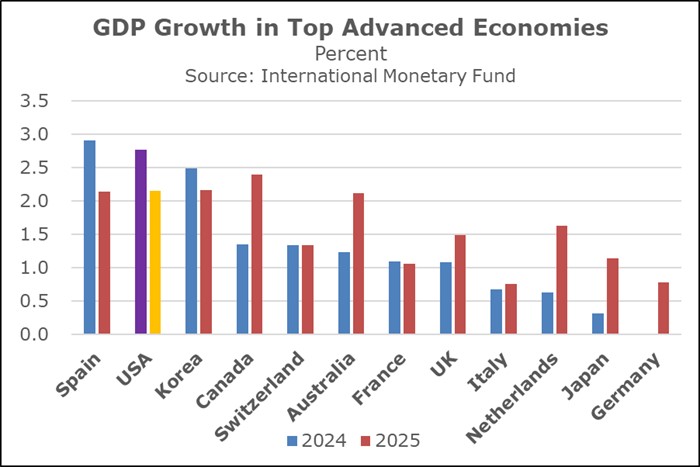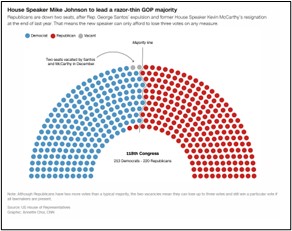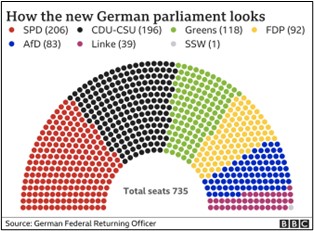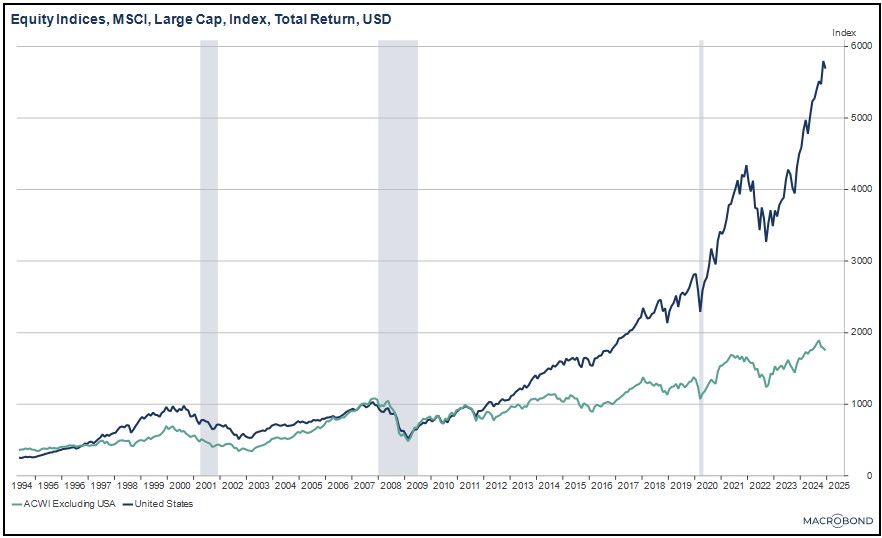Asset Allocation Bi-Weekly – American Exceptionalism and the Markets (February 3, 2025)
by the Asset Allocation Committee | PDF
We suspect many investors today think the “American Exceptionalism” they studied in high school or college no longer applies to the United States, given the challenges it faces from the rise of China, the country’s own enormous debt load, or its sharp political divisions. However, as we survey the global landscape in these still-early days of 2025, we are struck by the unusually positive trends we see in the US. Below, we lay out the US’s current economic growth, relatively smooth political transition, and outstanding stock market performance compared with other key countries. The US certainly has near-term challenges, but we think investors should understand how positively the US compares with many other investment regions today.
 Based on initial estimates, US gross domestic product in 2024 was up an inflation-adjusted 2.8% from the previous year, modestly beating the average growth rate of 2.1% over the last 20 years. As we’ve noted previously, some US economic sectors are struggling, especially those that are sensitive to high interest rates or depend on lower-income consumers. Still, data from the International Monetary Fund (IMF) shows that the US was one of only three major advanced countries to grow faster than their 20-year average last year (the others were Italy and Spain). Moreover, the IMF estimates the US economy will grow 2.2% in 2025, again a bit above its 20-year average and better than all major advanced countries except for Canada.
Based on initial estimates, US gross domestic product in 2024 was up an inflation-adjusted 2.8% from the previous year, modestly beating the average growth rate of 2.1% over the last 20 years. As we’ve noted previously, some US economic sectors are struggling, especially those that are sensitive to high interest rates or depend on lower-income consumers. Still, data from the International Monetary Fund (IMF) shows that the US was one of only three major advanced countries to grow faster than their 20-year average last year (the others were Italy and Spain). Moreover, the IMF estimates the US economy will grow 2.2% in 2025, again a bit above its 20-year average and better than all major advanced countries except for Canada.
Another underappreciated development in the US has been the smooth transition of political power since the November election. Of course, nearly half of US voters were disappointed by the Republican Party’s broad victory. All the same, US citizens of all persuasions have benefited from the fact that the election and transfer of power were completed without the widespread political violence many feared. The US’s overall political stability has been confirmed, and President Trump’s apparently clear mandate to effectuate change may well be better than the fractious, unstable coalitions and paralyzed minority governments that plague Europe and Asia today. For example, the charts below show the current party breakdowns of the US House of Representatives and the German Bundestag.
Finally, because of the US’s continued strong economic momentum and the clear runway for Trump to implement his program of supporting business and cutting regulation, it should be no surprise that US stocks have outperformed most other key markets. As shown in the chart below, the MSCI USA total return stock index rose 25.1% in 2024, while the MSCI ACWI ex-USA All Cap Index provided a total return of just 5.7%. Taking a somewhat longer view, the USA index provided an average annual total return of 14.6% over the last five years, handily beating the average total return of 4.6% for the ACWI ex-USA index. Of course, past performance doesn’t necessarily show what will happen in the future, especially since US stocks on average are very highly valued when compared with foreign stocks. Nevertheless, we think the relatively strong political and economic environment of the US should help support the country’s stock values in the near term. This environment has helped US firms dominate some of the world’s most important, innovative, high-growth stock sectors, such as Information Technology and Communication Services. US stock market capitalization is now heavily concentrated in those sectors. Of course, this creates the risk of a US correction or rotation to value stocks, small cap stocks, or other sectors. For now, however, it positions the US stock market to continue performing well as long as investors continue pouring funds into large, innovative, high-growth companies.
In sum, as we noted in our 2025 Outlook: A Year of Political and Policy Change, we expect US stocks to continue providing good returns in the coming months, albeit with the potential for volatility stemming from geopolitical events, policy changes, and the potential for stock market leadership to rotate between size, style, and sectors. This isn’t to say that there won’t be opportunities in foreign stocks or other asset classes. There certainly will be, and keen-eyed investors will likely be able to identify them. Many investors will also want to maintain exposure to foreign stocks and other asset classes for diversification purposes. All the same, this big-picture analysis suggests that US stocks should have the most wind at their backs in 2025.





